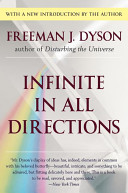Broken Symmetry
The discoveries of recent decades in particle physics have led us to place great emphasis on the concept of broken symmetry. The development of the universe from its earliest beginnings is regarded as a succession of symmetry-breakings. As it emerges from the moment of creation in the Big Bang, the universe is completely symmetrical and featureless. As it cools to lower and lower temperatures, it breaks one symmetry after another, allowing more and more diversity of structure to come into existence. The phenomenon of life also fits naturally into this picture. Life too is a symmetry-breaking. In the beginning a homogeneous ocean somehow differentiated itself into cells and animalcules, predators and prey. Later on, a homogeneous population of apes differentiated itself into languages and cultures, arts and sciences and religions. Every time a symmetry is broken, new levels of diversity and {44} creativity become possible. It may be that the nature of our universe and the nature of life are such that this process of diversification will have no end.
If this view of the universe as a steady progression of symmetry-breakings is valid, then Athens and Manchester fit in a natural way into the picture. The science of Athens, the science of Einstein, tries to find the underlying unifying principles of the universe by looking for hidden symmetries. Einstein's general relativity showed for the first time the enormous power of mathematical symmetry as a tool of discovery. Now we have reason to believe that the symmetry of the universe becomes explicit and the laws of its behavior become unified if we go back far enough into the past. Particle physics is at the moment at the threshold of a big new step in this direction with the construction of Grand Unified models of the strong and weak interactions. The details of the Grand Unified models are worked out by studying the dynamics and composition of the universe as it is presumed to have existed for an unimaginably small fraction of a second after its beginning. Whether or not the particular models now proposed turn out to be correct, there is no doubt that the concept of unifying physics by going back to a simpler and more symmetric past is a fruitful one. The science of Athens, what Einstein called the ancient dream that pure thought can grasp reality, is then nothing else than the exploration of our remotest past, "A la recherche du temps perdu" on a bolder scale than Proust ever imagined.
In a similar fashion, the science of Manchester and of Rutherford, the science of the diversifies, is an exploration of the universe oriented toward the future. The further we go into the future, the more diversity of natural structures we shall discover, and the more diversity of technological artifice we shall create. It is then easy to understand why we have two kinds of scientists, the unifiers looking inward and backward into the past, the diversifiers looking outward and forward into the future. Unifiers are people whose driving passion is to find general principles which will explain everything. They {45} are happy if they can leave the universe looking a little simpler than they found it. Diversifies are people whose passion is to explore details. They are in love with the heterogeneity of nature and they agree with the saying, "Le bon Dieu aime les details." They are happy if they leave the universe a little more complicated than they found it.
Notes:
Folksonomies: science diversification
Taxonomies:
/science (0.445640)
/science/phyiscs/atomic physics (0.445009)
/science/physics (0.353421)
Keywords:
Grand Unified models (0.904827 (negative:-0.513499)), broken symmetry (0.756027 (negative:-0.538961)), particle physics (0.698062 (negative:-0.538962)), unimaginably small fraction (0.666453 (negative:-0.513499)), underlying unifying principles (0.665257 (negative:-0.284216)), bon Dieu aime (0.655437 (positive:0.525572)), big new step (0.640429 (neutral:0.000000)), Symmetry The discoveries (0.618874 (negative:-0.538962)), mathematical symmetry (0.579623 (positive:0.457990)), universe (0.536133 (positive:0.398744)), great emphasis (0.524090 (negative:-0.538962)), homogeneous ocean (0.523710 (neutral:0.000000)), recent decades (0.522875 (negative:-0.538961)), earliest beginnings (0.519323 (negative:-0.362577)), homogeneous population (0.515431 (neutral:0.000000)), Big Bang (0.515370 (positive:0.623725)), steady progression (0.503209 (positive:0.785508)), lower temperatures (0.501819 (negative:-0.663985)), enormous power (0.498669 (positive:0.457990)), new levels (0.496522 (positive:0.319433)), bolder scale (0.493334 (positive:0.210797)), natural way (0.492992 (positive:0.809236)), la recherche (0.491336 (neutral:0.000000)), symmetric past (0.487786 (positive:0.687852)), weak interactions (0.487514 (neutral:0.000000)), ancient dream (0.485865 (neutral:0.000000)), technological artifice (0.485610 (positive:0.555033)), particular models (0.483920 (neutral:0.000000)), similar fashion (0.483796 (neutral:0.000000)), natural structures (0.477117 (positive:0.560781))
Entities:
Einstein:Person (0.885629 (positive:0.457990)), Athens:City (0.712013 (positive:0.809236)), Le bon Dieu aime:Facility (0.561171 (positive:0.525572)), Manchester:City (0.552985 (positive:0.809236)), Grand Unified:Facility (0.537212 (neutral:0.000000)), Rutherford:City (0.366833 (neutral:0.000000))
Concepts:
General relativity (0.976632): dbpedia | freebase | opencyc
Universe (0.792128): dbpedia | freebase
Nature (0.707601): dbpedia | freebase | opencyc
Physics (0.662089): dbpedia | freebase | opencyc
Time (0.654341): dbpedia | freebase | opencyc
Big Bang (0.651730): dbpedia | freebase | opencyc | yago
Standard Model (0.558391): dbpedia | freebase | yago
Physical cosmology (0.556088): dbpedia | freebase





